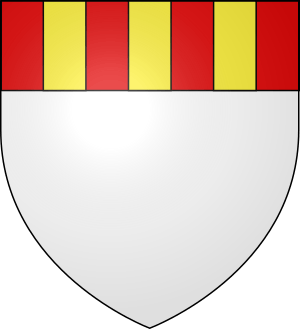Robert II Keith, Marischal of Scotland facts for kids
Quick facts for kids
Sir Robert Keith
|
|
|---|---|

Arms of Keith, Earl Marischal:
Argent, on a chief gules, three palets or. |
|
| Died | 11 August 1332 Dupplin Moor, Scotland |
| Allegiance | |
| Commands held | Scottish cavalry at Bannockburn |
| Battles/wars | Battle of Inverurie Battle of Bannockburn Battle of Dupplin Moor |
| Other work | Diplomat, again soldier |
Sir Robert Keith (who died on August 11, 1332) was a brave Scottish knight and a skilled diplomat. He held the important family title of Marischal of Scotland. This meant he was in charge of the royal household and military matters for the King of Scotland. Sir Robert Keith is best known for leading the Scottish cavalry at the famous Battle of Bannockburn.
Contents
What Was Sir Robert Keith's Early Life Like?
Sir Robert Keith came from a long line of important Scottish leaders. His family had held the title of Marischal of Scotland for many years, ever since the time of King Malcolm IV. This title was passed down from father to son.
Robert Keith was the great-great-grandson of Hervey de Keith, who was one of the first to hold this special role. His father was William de Keith. From a young age, Robert chose a military career. He was also seen as a strong leader by other Scottish nobles. He was even put in charge of justice for lands north of the River Forth.
When Did Sir Robert Keith First Fight for Scotland?
In 1300, Sir Robert Keith was captured by the English during a small fight near the River Cree. However, he was back in Scotland by 1308. In March 1309, he attended the very first parliament held by King Robert the Bruce in St Andrews. This shows how trusted and important he was to the King.
How Did Sir Robert Keith Help Win the Battle of Bannockburn?
Sir Robert Keith was a high-ranking general in King Robert the Bruce's army. This was during the long war for Scotland's independence from England. Before the big Battle of Bannockburn in 1314, he was chosen for a very important job. He was made a co-leader of a team sent to find out more about the English army.
What Was Sir Robert Keith's Role in the Battle?
During the Battle of Bannockburn, Sir Robert Keith was in command of about 500 Scottish cavalry. Cavalry are soldiers who fight on horseback. However, like many other Scottish knights, he might have fought on foot during the battle.
Keith's cavalry faced a tough challenge: the English archers. These archers were known for causing a lot of damage to Scottish foot soldiers in other battles. But Sir Robert Keith and his men were clever. They rode around the archers and attacked them from the side. This surprise attack made the archers run away.
What Was the Result of the Battle of Bannockburn?
The Battle of Bannockburn was a huge victory for the Scots. After this battle, King Robert the Bruce had full control over Scotland. The only place still held by the English was the town of Berwick-upon-Tweed.
What Did Sir Robert Keith Do After the Battle?
After the great victory at Bannockburn, Sir Robert Keith continued to serve Scotland. In 1320, he was one of the important Scottish nobles who signed a letter to the Pope. This letter bravely explained why Scotland should be an independent country. It is known as the Declaration of Arbroath.
What Were Sir Robert Keith's Diplomatic Missions?
Sir Robert Keith was also a skilled diplomat. A diplomat is someone who represents their country in talks with other countries. In 1323, he worked as a peace commissioner, trying to make peace with England. He also helped to approve the Treaty of Corbeil (1326) with the King of France. This treaty was an important agreement between Scotland and France.
How Did Sir Robert Keith Die?
Sadly, Sir Robert Keith was killed fighting for King David II of Scotland (Robert the Bruce's son) at the Battle of Dupplin Moor. This battle took place on August 11, 1332.
Who Were Sir Robert Keith's Family Members?
Sir Robert Keith's family continued to be important in Scotland. His grandson, also named Robert Keith, took over the title of Marischal. However, this grandson was killed in the Battle of Neville's Cross in 1346.
Sir Robert Keith's family, later known as the Earls Marischal, held their important title for many centuries. They played a big part in Scottish history for a long time.
| Political offices | ||
|---|---|---|
| Preceded by William Keith |
Marischal of Scotland |
Succeeded by Robert Keith |
| Legal offices | ||
| Preceded by John Comyn, Earl of Buchan |
Justiciar of Scotia c. 1305–1306 with Reginald Cheyne (c. 1305–1306) John de Vaux (c. 1305–1306) William Inge (c. 1305–1306) |
Succeeded by Uncertain, next known was Robert Lauder of Quarrelwood |

